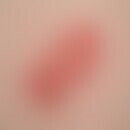DefinitionThis section has been translated automatically.
Imidazo-quinoline derivative with topical immunomodulating, antiviral, tumour-inhibiting effect.
Pharmacodynamics (Effect)This section has been translated automatically.
Imiquimod has an "immunomodulatory" effect.
Imiquimod activates the NLRP3 inflammasome (see below Inflammasome), which responds to cellular stress and tissue damage(Groß C 2016).
Furthermore, imiquimod binds to Toll-like receptors 7 and 8 on dendritic cells, macrophages and monocytes. Stimulation of these receptors triggers a proinflammatory response with synthesis of IFN, TNF, IL-1, IL-6 and IL-8, including stimulation of phosphorylation of the transcription factor NF kappa B (kappa gene enhancer binding protein) and transcription factors for interferon.
Imiquimod has been shown to reduce viral load in infected tissues.
Further studies show that imiquimod can activate Langerhans cells and promote their migration to draining lymph nodes.
You might also be interested in
IndicationThis section has been translated automatically.
- Approved for the topical treatment of condylomata acuminata (external genital and perianal warts) in adults
- Approved for the topical treatment of actinic keratoses and small superficial basal cell carcinomas in adults. Topical treatment is a suitable alternative to surgical resection for superficial tumors, especially multiple trunk skin basal cell carcinomas.
- Clinical successes (no approval), which are also documented in literature by individual case reports, have been reported in M. Bowen(off-label use). In addition, successes with mollusca contagiosa and therapy-resistant verrucae planae juveniles have been described in smaller studies. Individual observations exist on the successful treatment of lentigo maligna (off-label use) and the plaque stage of mycosis fungoides (off-label use).
Limited indicationThis section has been translated automatically.
Dosage and method of useThis section has been translated automatically.
- For the 5% Imiquimod cream (Aldara), use as follows: Apply a thin layer 3 times/week before bedtime and leave on the skin for 6-10 hours.
- For superficial basal cell carcinoma: Apply a thin layer once a day for 5 days/week and leave for 8-10 hours. Treatment for a total of 6 weeks. Numerous studies prove the good healing (80%). At present, however, the Imiquimod therapy is not yet covered by all statutory health insurance companies. It is recommended that you apply to your insurance company for coverage in advance of a planned therapy. Topical treatment is a suitable alternative to surgical resection for superficial tumors, especially for multiple trunk skin basal cell carcinomas.
- For actinic keratoses: application 3 times/week for 4 weeks at the affected areas. Further cycle if necessary. In an open study with 829 volunteers a cure rate of 85.4% was reported.
- Condylomata acuminata: application 3 times/week for a total of 3-4 weeks.
- For the 3.75% imiquimod in cream base (cyclara), the following application applies for actinic keratoses: 1 sachet of the cream is applied once a day in the evening to the face and/or the hairless scalp. The first treatment cycle lasts for 2 weeks, followed by a therapy break of 2 weeks, followed by another treatment phase of 2 weeks (2 on - 2 off - 2 on). If the local skin reactions (possibly also the systemic side effects), which usually occur at the end of the 2nd and 6th week of treatment, are not acceptable, the treatment can be temporarily interrupted. The complete remission is 67% 6 months after the end of treatment.
- Important information for the patient: If the skin is still intact, the pathologically altered keratinocytes attacked by the immune modulation become visible. In this respect, more or larger lesions appear than originally suspected. The patient should be informed about this before the therapy.
Undesirable effectsThis section has been translated automatically.
Remember!
According to our own experience, headaches, flu-like symptoms (fever) and myalgia are not uncommon (5-10% of patients) despite topical application. Also: erythema, erosion, excoriation, scaling and oedema in the areas of application. Rarely induration, ulceration, scabbing and blistering. In one case a capillary leak syndrome with fatal outcome (multiorgan failure) was attributed to the use of Imiquimod. The tensile strength of condoms and vaginal pessaries can be affected. In patients with many treated skin lesions, strong manifestations of the above-mentioned side effects in the sense of a stronger immune induction are known.PreparationsThis section has been translated automatically.
Aldara 5% cream; Cyclara 3,75% cream (see also http://online.rote-liste.de/suche/stoff/990617)
LiteratureThis section has been translated automatically.
- Beutner KR et al (1999) Therapeutic response of basal cell carcinoma to the immune response modifier imiquimod 5% cream. J Am Acad Dermatol 41: 1002-1007
- Cook-Bolden F, vineyard JM (2002) Topical imiquimod 5% cream in the treatment of Bowen's disease of the penis. J Am Acad Dermatol 46: 146-147
- Deeths MJ et al (2005) Treatment of patch and plaque stage mycosis fungoides with imiquimod 5% cream. J Am Acad Dermatol 52: 275-280
- Diaz-Arrastia C et al (2001) Clinical and molecular responses in high-grade intraepithelial neoplasia treated with topical imiquimod 5%. Clin Cancer Res 7: 3031-3033
- Drehs MM et al (2002) Successful treatment of multiple superficial basal cell carcinomas with topical imiquimod: case report and review of the literature. Dermatol Surgery 28: 427-429
- Epstein E (2003) Extensive lentigo maligna clearing with topical imiquimod. Arch Dermatol 139: 944-945
- Firooz A et al (2006) Imiquimod in combination with meglumine antimoniate for cutaneous leishmaniasis: a randomized assessor-blind controlled trial. Arch Dermatol 142: 1575-1579
- Geisse J et al (2004) Imiquimod 5% cream for the treatment of superficial basal cell carcinoma: results from two phase III, randomized, vehicle-controlled studies. J Am Acad Dermatol 50: 722-733
- Groß CJ et al.m(2016) Efflux-Independent NLRP3 Inflammasome Activation by Small MoleculesTargeting
Mitochondria. Immunity 45:761-773. - Hengge UR (2001) Topical immunomodulators--progress towards treating inflammation, infection, and cancer. Lancet Infect Dis 1: 189-198
- Hengge UR, Stark R (2001) Topical imiquimod to treat intraepidermal carcinoma. Arch Dermatol 137: 709-711
- Kagy MK, Amonette R (2000) The use of imiquimod 5% cream for the treatment of superficial basal cell carcinomas in a basal cell nevus syndrome patient. Dermatol Surgery 26: 577-578
- Mackenzie-Wood A (2001) Imiquimod 5% cream in the treatment of Bowen's disease. J Am Acad Dermatol 44: 462-470
- Marks R et al (2001) Imiquimod 5% cream in the treatment of superficial basal cell carcinoma: results of a multicenter 6-week dose-response trial. J Am Acad Dermatol. 44: 807-813
- Netzwerk aktuell (2004) Capillary leak syndrome under Imiquimod (Aldara cream). Medication telegram 35: 16
- Oster-Schmidt C (2001) Imiquimod: an new possibility for the treatment-resistant verrucae planae. Arch Dermatol 137: 666-667
- Smith KJ et al (2002) Topical 5% imiquimod for the therapy of actinic cheilitis. J Am Acad Dermatol 47: 497-501
- Sterry W, Ruzicka T et al (2002) British Journal of Dermatology 147: 1227-1236
- Stockfleth E et al (2004) Low incidence of new actinic keratoses after topical 5% imiquimod cream treatment: a long-term follow-up study. Arch Dermatol 140: 1542
- Stockfleth E et al (2002) A randomized, double-blind, vehicle-controlled study to assess 5% imiquimod cream for the treatment of multiple actinic keratoses. Arch Dermatol 138: 1498-1502
- Stockfleth E et al (2001) Successful treatment of actinic keratosis with imiquimod cream 5%: a report of six cases. Br J Dermatol 144: 1050-1053
- Wigbels B (2001) Imiquimod: a new treatment possibility in bowenoid papulosis? dermatologist 52: 128-131




